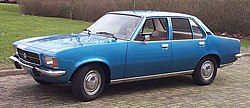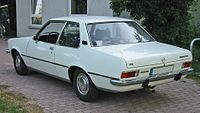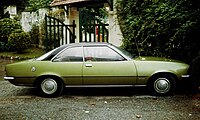Opel Rekord D
| Opel | |
|---|---|
|
Opel Rekord (1971–1977)
|
|
| Record D | |
| Sales designation: | Record II / record |
| Production period: | 12 / 1971-07 / 1977 |
| Class : | upper middle class |
| Body versions : | Limousine , station wagon , coupé , panel van |
| Engines: |
Otto engines : 1.7–2.0 liters (44–74 kW) Diesel engine : 2.1 liters (44 kW) |
| Length: | 4567-4607 mm |
| Width: | 1718 mm |
| Height: | 1415 mm |
| Wheelbase : | 2668 mm |
| Empty weight : | 1065-1230 kg |
| Previous model | Opel Rekord C |
| successor | Opel Rekord E. |
The Opel Rekord D is an upper middle class vehicle from Adam Opel AG . In South Africa and some European countries the model was also known under the model name Ranger B , and in South Korea from Shinjin Motors under the names Shinjin Record 1900, Shinjin Record Royale and in Iran as Chevrolet Iran.
The Rekord D was also the basis for the Opel Commodore B introduced in March 1972 .
Model history
General
The Opel Rekord D drawn by the designer Chuck Jordan was officially presented in January 1972 as the successor to the Opel Rekord C. At first it was called "Record II" in order not to be misinterpreted as a diesel model.
From July 1972 a diesel version with a displacement of 2.1 liters was available, with 2.0 liters and 56 hp for export. These models were recognizable by a hump on the bonnet. This hump was necessary because the diesel engine was higher than the petrol engines because of the overhead camshaft. The taxi industry was targeted with the diesel model. Mercedes-Benz had been the sole manufacturer of diesel cars in Germany since 1954 , which changed with the D 2100 record. Other vehicle manufacturers are now slowly following suit. The curb weight of the petrol engine vehicles was 1065 to 1090 kg. The models with a diesel engine weighed 1210 to 1230 kg.
The self-supporting all-steel body offered space for five people. It was available in five different versions: as a two- and four-door sedan , as a three- and five-door caravan and as a coupé . Furthermore, outside of Germany there were also three-door caravans without rear windows called delivery vans .
The front wheels were suspended from double wishbones of unequal length with coil springs (at a progressive rate) and had torsion bar stabilizers and telescopic shock absorbers. The vehicle was equipped with a recirculating ball steering system and a flexible safety steering column. At the rear was a rigid axle with four trailing arms, Panhard rod, coil springs with progressive rate, torsion bar stabilizer and telescopic shock absorbers. Early versions had steering wheel shift as standard (except for coupes), the diesel models until the end of production. The "sports circuit" called the middle circuit initially cost a small surcharge and was not available for the diesel versions. A 3-speed automatic transmission was also available on request.
In 1975, the change was due to the gasoline lead Act the lead content (as tetraethyl limited) in the fuel to less than half of the previous values. Therefore, the compression ratio of the engines had to be reduced in order to continue to operate the engine safely below the knock limit . The output of the 1700 N engine was therefore reduced by 6 hp, the 1700 S engine was discontinued, and the range was supplemented by the 1900 N engine (normal gasoline). The performance of the 1900 SH engine (premium petrol / hydraulic valve lifters) was reduced from 97 to 90 hp, and the 2000 S with 100 hp was also available from September 1975.
The Rekord D was produced from December 1971 to July 1977 in 1,128,196 copies. Its successor was the Opel Rekord E 1.
Model and equipment variants
The Rekord D was available as a basic version, as a luxury version “Rekord L” and with sporty equipment as a “Rekord Sprint”. In September 1974 the "Berlina" equipment line was added, which compared to the "L" version placed even more emphasis on comfort and equipment.
The production number of one million copies of the Rekord D was celebrated with the special model "Millionär", which appeared in September 1976. The "Maharajah", "Hit" and "Sport" versions followed in the spring of 1977 as further special models.
Data table
| Technical data Opel Rekord D 1971–1977 | |||||||
| Opel record: | 1700 | 1700 p | 1900 | 1900 p | 1900 SH | 2000 pp | 2100 D |
|---|---|---|---|---|---|---|---|
| Engine: | 4-cylinder in-line engine (four-stroke) | ||||||
| Displacement: | 1698 cc | 1897 cc | 1979 cc | 2068 cc | |||
| Bore × stroke: | 88 x 69.8 mm | 93 x 69.8 mm | 95 x 69.8 mm | 88 × 85 mm | |||
| Performance at 1 / min: | 44–49 kW (60–66 hp) for 4800–5300 |
61 kW (83 PS) at 5400 |
55 kW (75 PS) at 4800 |
66 kW (90 PS) at 4400 |
71 kW (97 hp) at 4800 |
74 kW (100 PS) at 5200 |
44 kW (60 hp) at 4400 |
| Max. Torque at 1 / min: | 112-118 Nm at 2500-2600 | 127 Nm at 3200 | 132 Nm at 2800 | 145 Nm at 3800 | 147 Nm at 3800 | 155 Nm at 3600 | 118 Nm at 2500 |
| Compression: | 8.2, later 8.0: 1 | 9.8: 1 | 7.6: 1 | 8.8: 1 | 9.8: 1 | 9.0: 1 | 22.0: 1 |
| Mixture preparation: | 1 downdraft carburetor | 1 register downdraft carburetor | Bosch diesel injection pump | ||||
| Valve control: | Overhead valves and rocker arms (side camshaft in cylinder head, duplex chain) | Overhead valves and rocker arms (overhead camshaft, duplex chain) | |||||
| Cooling: | Water cooling | ||||||
| Transmission: | 4-speed gearbox, steering wheel or stick shift (a. W. three-speed automatic (Opel)) | ||||||
| Front suspension: | Independent suspension on double wishbones , coil springs | ||||||
| Rear suspension: | Rigid axle with double trailing arms and Panhard rod , coil springs | ||||||
| Steering: | Recirculating ball steering | ||||||
| Body: | Sheet steel, self-supporting | ||||||
| Track width front / rear: | 1419/1400 mm | ||||||
| Wheelbase: | 2668 mm | ||||||
| Length: | 4567-4635 mm | ||||||
| Empty weight: | 1090-1330 kg | ||||||
| Top speed: | 135-143 km / h | 155-160 km / h | 145-150 km / h | 155-160 km / h | 160-165 km / h | 165-170 km / h | 127-135 km / h |
| 0-100 km / h: | 20-26 s | 16-18.5 s | 17-20 s | 15-17.5 s | 14-16.5 s | 13-14 p | 23.5-32 s |
| Consumption (liters / 100 kilometers): | 12.0-13.5 N | 12.5-14.0 S | 12.5-14.0 S | 12.5-14.0 S | 12.5-14.0 S | 12.0-13.5 S. | 8-9.5D |
literature
- Werner Oswald : German Cars 1945–1990 . Motorbuch Verlag, Stuttgart 2003, ISBN 3-613-02116-1 , pp. 251-257.
Web links
Individual evidence
- ^ A b c d Eckhart Bartels, Rainer Manthey: Opel: Vehicle Chronicle Volume 2: 1952–1990. Podszun, Brilon 2012, ISBN 978-3-86133-620-4 , pp. 8/9 and 50.








